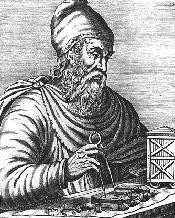SAND RECKONER
(Arenarius) by Archimedes
Translated and introduced
by Henry Mendel
Cal State Univ., L.A.
1. Marking the parts of numbers Since Archimedes counts in groups of 10000 (myriad), higher numbers are separated by a comma after the fourth and not the third unit, as is our practice. E.g. 10,0000 instead of 100,000.
In the notes a number in his system is given with its rank as a subscript. 13247 is 1324 of the seventh rank, i.e., 1324 * 1049-1 or more in our notation 1.324 *1051.
2. Some numbers are translated as follows:
number noun adjective translation explanation Greek translation explanation Greek unit not a number one one something octet eight units grouped together eight eight somethings decad ten units grouped together ten ten somethings hekatontad one hundred units grouped together hundred one-hundred somethings chiliad one thousand units grouped together thousand one thousand somethings myriad 10,000 units grouped together ten-thousand ten-thousand somethings
Multipliers are treated as 'n-times', e.g., 'three-myriad-times' or '3,0000-times' for.
Explanation of this awkward decision:
Where we commonly use only three words, although we have many alternative words for some numbers, Archimedes uses five different words for numbers, as is standard in Ancient Greek:
1. cardinal adjective, which can be used as a noun with a plural neuter article,How to translate three of these is straight-forward.
2. cardinal noun, which is a feminine singular
3. adverb indicating multiplication,
4. ordinal adjective.
5. numerical symbols.1. Cardinal adjectives may be translated by the standard English words for number, 'one', 'two', 'three', ..., except where the words are used as nouns, where English misses the plural. Nonetheless, I translate the noun form by these.The other two are not so obvious. How are we to translate the other two without artificiality?
4. Ordinals may be translated as 'first', 'second', etc.
5. Numerical symbols may be translated with Arabic numerals, but with a loss, since the difficulty that Archimedes is attempting to deal with is not obvious. See the survey below of theGreek number system based on the alphabet. Keep in mind that numerical symbols could be used as ordinals as well (just as we write '5th'). Also the older, and possibly more common system, even in the time of Archimedes, was based on iterations of symbols for 1, 5, 10, etc. In the case of symbols for 5 and up, this was based on abbreviations of the name of the number, e.g.for 20 or 2 tens or 2
(deka).
The adverb indicating multiplication is translated by the number with the affix 'times', e.g. 'thirty-six-times', rather than attempting to form general forms from 'triple', etc.Note that it is wrong to think of an octad as a set of eight units. It is eight units grouped together as a single unit.The cardinal noun is not so obvious. Here are some nouns for numbers in English:
monad, dyad, ennead, octad, decad (or decade). The Greek occurs for some numbers in English.Any of these, except the last, creates an artificiality. Hence, it is tempting to translateduet, trio, quartet, quintet, ..., octet, ...
doublet, triplet, quadruplet, ..., octuplet, ...
unit, pair
as 'ten-thousand-units'. This proves even more artificial and prevents our speaking of more than one myriad without further linguistic contortion. For this reason I chose 'unit' and the Anglicizations of Greek nouns for numbers.
Greek Alphabetic Numerals
In the fifth century, a system of numbers was developed based on the Ionian alphabet supplemented. Although the system was not commonly adopted for a long time, it becomes the preferred system for Hellenistic mathematicians.
The system has a distinct digit for the units, 1, ..., 9, for the tens, for the hundreds, etc. To indicate that a sequence of symbols is a number, it is common to place a horizontal line above the number, although there were other conventions. Fractional parts (one nth), incidentally, will normally have a line drawn almost vertically above the same numerical symbol.
There are three sets of 9 numerals from the Ionian alphabet (24 letters) with an additional 3 letters (6, 90, 900). In this way one can write numbers up to 999 or
.
1 A 2 B 3 4 5 E 6 7 Z 8 H 9 10 I 20 K 30 40 M 50 N 60 70 O 80 90 100 200 300 T 400 500 600 700 800 900 or
A slash on the left side of a numeral up tomultiplies the digit by 1000, i.e., 1000 =
. In this way, one can write numbers up to 9999 or
. This is the highest number in this series, e.g.
does not occur as a symbol for 1,0000. Part of the reason for this must be that people conceived of 1,0000 as a unit of large counting, as reflected in Archimedes' treatise.
There are several ways of extending the system by taking M , for 'myriad' (keep in mind that M is the digit for 40). Placed beneath a number multiplies it by 1,0000. For example, 1,0000 is
. In this way, one can write a number up to 9999,9999 or
. However, this is as high as one can go. Hence, Archimedes presents his proposal for larger numbers. Another method is to place the abbreviation
before the number of myriads.
Later systems are based on iterating myriads with a separator.
Henry Mendell (Cal. State U., L.A.)
Continue on to Chapter One Return to the Table of Contents
Return to List of Authors and Books
